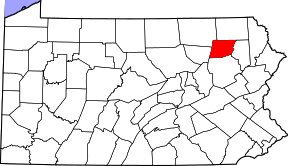Meshoppen, Pennsylvania
| Borough of Meshoppen | |
|---|---|
| Borough | |
|
Meshoppen's Old White Mill | |
 Location of Meshoppen in Wyoming County, Pennsylvania. | |
 Meshoppen Location of Meshoppen in Pennsylvania  Meshoppen Meshoppen (the US) | |
| Coordinates: 41°36′53″N 76°02′47″W / 41.61472°N 76.04639°WCoordinates: 41°36′53″N 76°02′47″W / 41.61472°N 76.04639°W | |
| Country | United States |
| State | Pennsylvania |
| County | Wyoming |
| Government | |
| • Mayor | Ian Hemann |
| Area[1] | |
| • Total | 0.78 sq mi (2.01 km2) |
| • Land | 0.69 sq mi (1.79 km2) |
| • Water | 0.09 sq mi (0.22 km2) |
| Elevation | 623 ft (190 m) |
| Population (2010) | |
| • Total | 563 |
| • Estimate (2016)[2] | 548 |
| • Density | 793.05/sq mi (306.31/km2) |
| Time zone | UTC-5 (EST) |
| • Summer (DST) | UTC-4 (EDT) |
| ZIP Code | 18630 |
| Area code(s) | 570 Exchange: 833 |
| FIPS code | 42-48856 |
| Website |
www |
Meshoppen is a borough in Wyoming County, Pennsylvania, United States. The population was 563 at the 2010 census.
History
Meshoppen comes from the Unami-Len'api term Mel'ansch'pen'ing [3] or the Minsi-Len'api term Mech'mel'an'unk[4] which means "place of beads". The area was lightly settled by the Minsi-Len'api ("scattered people") and members of the Goano'ganochsejeh'eroni or "Big House People" (AKA Iroquois League), specifically Eroni (people) from Onon'yot'a'da ("Standing-stone-place"—modern Oneida, New York) and Onondaga ("Hill-place"—modern Syracuse, New York), from 1740-65.
The Old White Mill was listed on the National Register of Historic Places in 1975.[5]
Geography
Meshoppen is located at 41°36′53″N 76°2′47″W / 41.61472°N 76.04639°W (41.614691, -76.046276).[6]
According to the United States Census Bureau, the borough has a total area of 0.7 square miles (1.8 km2), all of it land.
Demographics
| Historical population | |||
|---|---|---|---|
| Census | Pop. | %± | |
| 1880 | 554 | — | |
| 1890 | 597 | 7.8% | |
| 1900 | 609 | 2.0% | |
| 1910 | 630 | 3.4% | |
| 1920 | 608 | −3.5% | |
| 1930 | 525 | −13.7% | |
| 1940 | 580 | 10.5% | |
| 1950 | 574 | −1.0% | |
| 1960 | 470 | −18.1% | |
| 1970 | 482 | 2.6% | |
| 1980 | 571 | 18.5% | |
| 1990 | 439 | −23.1% | |
| 2000 | 459 | 4.6% | |
| 2010 | 563 | 22.7% | |
| Est. 2016 | 548 | [2] | −2.7% |
| Sources:[7][8][9] | |||
As of the census[10] of 2010, there were 563 people, 190 households, and 128 families residing in the borough. The population density was 804.3 people per square mile (310.5/km²). There were 217 housing units at an average density of 310 per square mile (121.1/km²). The racial makeup of the borough was 89.2% White, 3.7% African American, 0.65% Native American, 0.65% Asian, 4.3% from other races, and 1.4% from two or more races. Hispanic or Latino of any race were 10.1% of the population.
There were 190 households out of which 46.3% had children under the age of 18 living with them, 38.9% were married couples living together, 18.9% had a female householder with no husband present, and 32.6% were non-families. 23.7% of all households were made up of individuals and 5.8% had someone living alone who was 65 years of age or older. The average household size was 2.96 and the average family size was 3.46.
In the borough the population was spread out with 31.4% under the age of 18, 61.7% from 18 to 64, and 6.9% who were 65 years of age or older. The median age was 29 years.
The median income for a household in the borough was $40,714, and the median income for a family was $38,594. Males had a median income of $30,417 versus $22,063 for females. The per capita income for the borough was $16,588. About 13.5% of families and 22.7% of the population were below the poverty line, including 37.2% of those under age 18 and 15% of those age 65 or over.
Government
Mayor
| Bruce Marshall | Democratic |
Council
| Council Member | Party |
|---|---|
| Herb Bevan | Republican |
| John V. Bunnell | Democratic |
| Michael Vorhees | Republican |
| Mike Loyd | Democratic |
| Bruce Priestner | Republican |
| Doris Pickett | Republican |
| Jack Vaow | Democratic |
References
- ↑ "2016 U.S. Gazetteer Files". United States Census Bureau. Retrieved Aug 14, 2017.
- 1 2 "Population and Housing Unit Estimates". Retrieved June 9, 2017.
- ↑ Brinton, Daniel G., C.F. Denke, and Albert Anthony. A Lenâpé - English Dictionary. Biblio Bazaar, 2009. ISBN 978-1103149223, p. 79.
- ↑ Zeisberger, David. Indian Dictionary: English, German, Iroquois—The Onondaga and Algonquin—The Delaware. Harvard University Press, 1887. ISBN 1104253518, p. 218. “The Delaware” that Zeisberger translated was Minsi-Len’api.
- ↑ National Park Service (2009-03-13). "National Register Information System". National Register of Historic Places. National Park Service.
- ↑ "US Gazetteer files: 2010, 2000, and 1990". United States Census Bureau. 2011-02-12. Retrieved 2011-04-23.
- ↑ "Census of Population and Housing". U.S. Census Bureau. Retrieved 11 December 2013.
- ↑ "American FactFinder". United States Census Bureau. Retrieved 2008-01-31.
- ↑ "Incorporated Places and Minor Civil Divisions Datasets: Subcounty Resident Population Estimates: April 1, 2010 to July 1, 2012". Population Estimates. U.S. Census Bureau. Archived from the original on 17 June 2013. Retrieved 11 December 2013.
- ↑ "American FactFinder". United States Census Bureau. Retrieved 2011-05-14.
